Visualization, the art of creating vivid mental images, is a potent tool for personal growth, achievement, and well-being. By harnessing the power of the mind, we can shape our reality, overcome challenges, and unlock our full potential.
From the ancient practice of meditation to modern-day performance enhancement strategies, visualization has been employed by countless individuals to achieve extraordinary results. Whether you’re an athlete seeking peak performance, a business professional aiming for success, or simply someone looking to enhance overall life satisfaction, visualization can be a transformative tool.
Core Visualization Techniques

Mental Rehearsal
This technique involves mentally practicing a desired outcome or action, such as a sports performance, a public speech, or a challenging task. By repeatedly visualizing success, athletes, performers, and individuals alike can improve their skills, reduce anxiety, and enhance confidence.
Guided Imagery Journey
Guided imagery involves following a verbal or auditory guide to create specific mental images and experiences. This technique can promote relaxation, stress reduction, pain management, and personal growth. It often includes visualizations of peaceful environments, positive body sensations, or desired outcomes.
Mind Palace Technique
Also known as the Method of Loci, this technique involves creating a mental palace or imaginary location with familiar landmarks. Information to be remembered is then associated with specific locations within the palace. By mentally walking through the palace, individuals can recall the information in a structured and organized manner.
Vision Board Creation
A vision board is a visual representation of goals and aspirations. It typically consists of images, words, and affirmations that inspire and motivate. By creating and regularly reviewing a vision board, individuals can clarify their goals, maintain focus, and increase motivation.
Affirmation Visualization
Affirmations are positive statements about oneself that can be used to challenge and overcome negative thoughts. Affirmation visualization involves combining affirmations with mental imagery to reinforce positive beliefs and create a desired reality.
Power Pose Visualization
Power posing involves adopting open and expansive body postures to boost confidence and reduce stress. Power pose visualization entails mentally practicing these postures to elicit similar physiological and psychological benefits as physically performing them.
Gratitude Visualization
Focusing on gratitude can enhance overall well-being and reduce negative emotions. Gratitude visualization involves mentally appreciating and focusing on positive aspects of life, such as relationships, experiences, and achievements.
Obstacle Overcoming Visualization
This technique involves mentally rehearsing strategies to overcome challenges and obstacles. By visualizing successful problem-solving and overcoming difficulties, individuals can build resilience and increase their ability to handle adversity.
Future Self Visualization
Envisioning a desired future self can provide motivation and direction. Future self visualization involves creating a mental image of oneself in the future, having achieved goals and living a fulfilling life. This technique can help individuals make choices aligned with their long-term vision.
Success Visualization
Success visualization involves creating vivid mental images of achieving desired outcomes. By focusing on the feelings, sensations, and details associated with success, individuals can enhance motivation, confidence, and performance.
Regular practice of these visualization techniques can lead to significant improvements in various areas of life, including personal and professional goals, emotional well-being, and overall quality of life.
Data Visualization Techniques
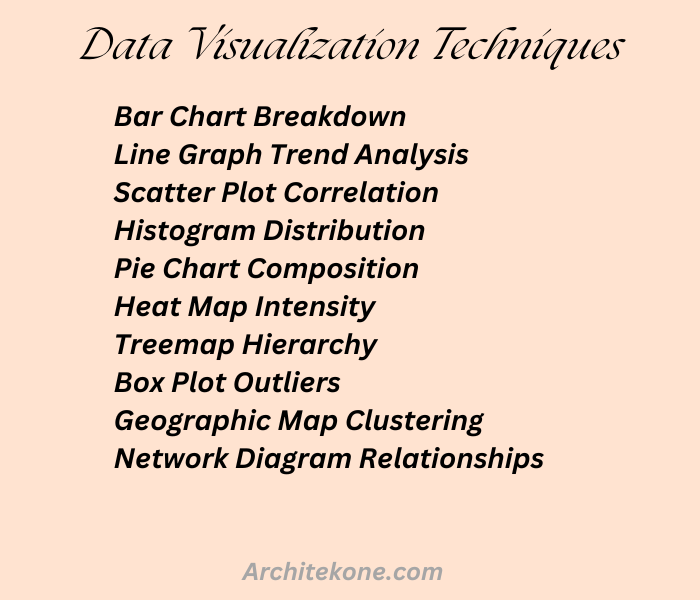
Bar Chart Breakdown
A bar chart is a visual representation of categorical data, where rectangular bars represent different categories. The length or height of each bar corresponds to the value it represents. Bar charts are effective for comparing values across categories, identifying trends, and highlighting outliers.
Line Graph Trend Analysis
A line graph displays data points connected by straight line segments. It is primarily used to visualize trends over a continuous variable, such as time. By observing the direction and steepness of the line, analysts can identify patterns, growth, decline, or stability in the data.
Scatter Plot Correlation
A scatter plot is a graph that displays the relationship between two numerical variables. Each data point represents a pair of values, plotted as a coordinate on the chart. By analyzing the pattern of the points, one can identify positive, negative, or no correlation between the variables.
Histogram Distribution
A histogram is a graphical representation of the distribution of numerical data. It divides data into intervals (bins) and displays the frequency or count of values falling within each bin. Histograms help visualize the shape, center, spread, and potential outliers of the data.
Pie Chart Composition
A pie chart is a circular statistical graphic that represents numerical proportions by dividing a circle into sectors. Each sector represents a category, and its size corresponds to the proportion of the whole it represents. Pie charts are useful for showing the composition of a whole.
Heat Map Intensity
A heat map uses color to represent data values in a matrix format. Warmer colors typically indicate higher values, while cooler colors represent lower values. Heat maps are effective for visualizing patterns, trends, and relationships within large datasets.
Treemap Hierarchy
A treemap is a visualization that displays hierarchical data as nested rectangles. The size of each rectangle corresponds to the value it represents, and the rectangles are arranged within larger rectangles to show hierarchical relationships. Treemaps are useful for visualizing hierarchical structures and comparing values across different levels.
Box Plot Outliers
A box plot (or box and whisker plot) is a graphical representation of the distribution of numerical data. It displays the median, quartiles, and potential outliers. The box represents the interquartile range (IQR), while whiskers extend to the minimum and maximum values within a specified range. Outliers are often plotted as individual points.
Geographic Map Clustering
A geographic map is a visual representation of geographic data, such as locations, boundaries, and features. Clustering on a geographic map involves grouping data points based on their spatial proximity. This technique helps identify patterns, hotspots, and spatial relationships within the data.
Network Diagram Relationships
A network diagram (or graph) is a visual representation of relationships between entities. Nodes represent entities, and edges represent connections between them. Network diagrams are used to analyze complex systems, identify influential nodes, and understand the structure of relationships within a network.
Creative Visualization Techniques

Dream Board Manifestation
A dream board is a visual representation of your goals and aspirations. By collecting images, words, and objects that symbolize your desired future, you create a powerful tool for motivation and manifestation. Regularly engaging with your dream board can help clarify your vision, increase focus, and attract opportunities aligned with your desires.
Storyboarding Your Goals
Similar to creating a storyboard for a film, this technique involves breaking down your goals into a sequence of steps or scenes. Visualizing each step as a frame in a story can help you identify potential challenges, develop strategies, and maintain momentum towards your desired outcome.
Sketching Your Vision
Drawing or sketching your goals and dreams can be a liberating and expressive way to visualize your aspirations. This process allows you to tap into your creativity and generate new ideas. By giving form to your vision, you can gain clarity, identify patterns, and unlock innovative solutions.
Mood Board Inspiration
A mood board is a collection of images, colors, textures, and words that evoke a specific feeling or atmosphere. By creating a mood board centered around your goals, you can immerse yourself in the desired emotional state and stimulate creativity. This technique can inspire new ideas, enhance motivation, and foster a positive mindset.
Color Therapy for Focus
Colors are known to evoke different emotions and mental states. By incorporating specific colors into your visualization practices, you can enhance focus, clarity, and energy levels. For example, blue can promote calmness and concentration, while red can stimulate passion and motivation.
Object Meditation
Choosing objects that symbolize your goals can deepen your connection to your aspirations. By meditating on these objects, you can enhance visualization, promote mindfulness, and create a stronger energetic connection to your desired reality.
Symbolic Representation
Assigning symbolic meanings to images, colors, or objects can add depth and richness to your visualizations. This technique allows you to tap into the power of symbolism to connect with deeper levels of consciousness and unlock hidden insights.
Creative Problem-Solving
Visualization can be a powerful tool for overcoming challenges and finding innovative solutions. By mentally exploring different possibilities and outcomes, you can generate new ideas, identify potential obstacles, and develop creative strategies.
Visualization for Innovation
Imagining new products, services, or processes can stimulate creativity and drive innovation. By visualizing the desired outcome and exploring different paths to achieve it, you can foster a mindset of possibility and generate groundbreaking ideas.
Artistic Expression
Engaging in artistic activities, such as painting, drawing, or sculpting, can be a powerful way to express your vision and goals. This process allows you to tap into your subconscious mind and uncover new perspectives. By giving form to your ideas, you can gain clarity, inspiration, and a deeper understanding of your aspirations.
Therapeutic Visualization
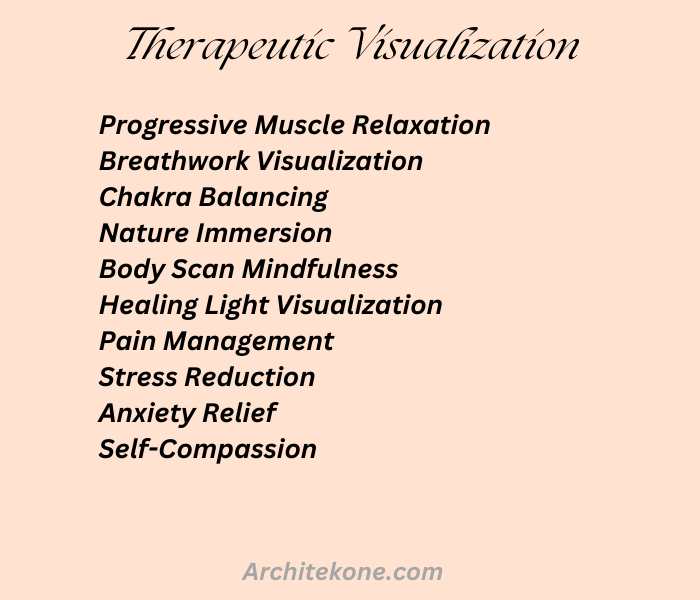
Progressive Muscle Relaxation
This technique involves systematically tensing and relaxing different muscle groups in the body. By contrasting tension with relaxation, individuals can become more aware of physical tension and learn to release it. This practice can reduce stress, anxiety, and muscular pain.
Breathwork Visualization
Breathwork combines deep, intentional breathing with visualization to promote relaxation and focus. By directing attention to the breath and creating mental images of calm and peace, individuals can reduce stress, improve mood, and enhance overall well-being.
Chakra Balancing
Chakras are energy centers in the body, according to ancient Indian philosophy. Chakra balancing involves techniques to align and harmonize these energy centers. This practice is believed to promote physical, emotional, and spiritual well-being.
Nature Immersion
Spending time in nature has been shown to reduce stress, improve mood, and enhance cognitive function. Nature immersion involves immersing oneself in natural environments, such as forests, parks, or beaches, to reap these benefits.
Body Scan Mindfulness
A body scan is a mindfulness technique that involves bringing focused attention to different parts of the body. By systematically scanning the body, individuals can increase body awareness, reduce stress, and cultivate a sense of relaxation.
Healing Light Visualization
This technique involves imagining healing light or energy flowing through the body. By visualizing this light, individuals can promote relaxation, reduce pain, and foster a sense of well-being.
Pain Management
Pain management techniques aim to reduce the intensity and impact of physical pain. These techniques can include relaxation techniques, mindfulness, and visualization, as well as physical therapies and medications.
Stress Reduction
Stress reduction encompasses various techniques designed to lower stress levels. These techniques may include relaxation exercises, time management strategies, and lifestyle modifications.
Anxiety Relief
Anxiety relief techniques focus on reducing symptoms of anxiety, such as worry, restlessness, and fatigue. These techniques often involve relaxation, breathing exercises, and cognitive-behavioral strategies.
Self-Compassion
Self-compassion involves treating oneself with kindness, understanding, and acceptance. This practice can help reduce self-criticism, build resilience, and enhance overall well-being.
Performance Enhancement
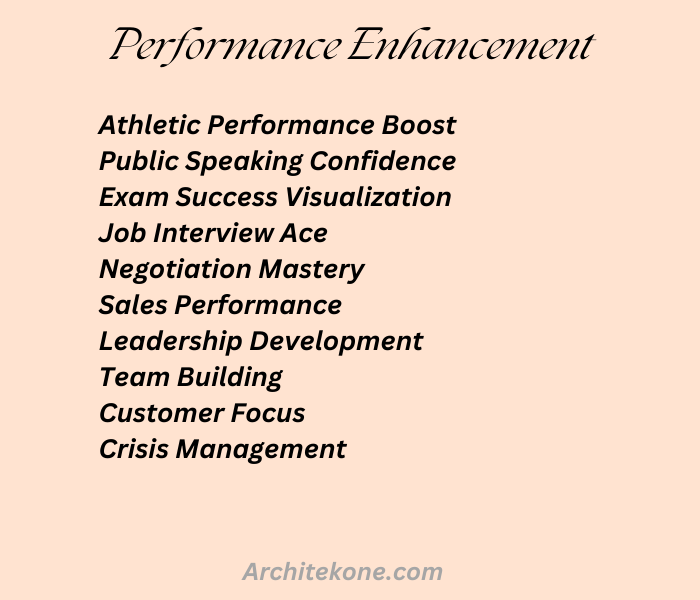
Athletic Performance Boost
By visualizing successful performance, athletes can enhance focus, improve motor skills, and build mental toughness. Visualizing specific movements, overcoming challenges, and achieving desired outcomes can optimize physical and mental preparation for competitions.
Public Speaking Confidence
Visualizing a confident and engaging presentation can significantly reduce anxiety and enhance performance. By imagining a positive audience response, overcoming stage fright, and delivering a compelling message, individuals can boost their public speaking abilities.
Exam Success Visualization
Students can leverage visualization to improve exam performance by creating mental images of understanding complex concepts, solving problems effectively, and confidently answering questions. This technique can reduce test anxiety and optimize cognitive function.
Job Interview Ace
Visualizing a successful job interview can increase confidence and improve interview performance. By imagining strong answers to potential questions, building rapport with the interviewer, and confidently showcasing qualifications, job seekers can enhance their chances of landing their desired position.
Negotiation Mastery
Visualization can be employed to prepare for and conduct successful negotiations. By mentally rehearsing different scenarios, developing persuasive arguments, and achieving desired outcomes, negotiators can improve their negotiation skills and increase their chances of reaching favorable agreements.
Sales Performance
Sales professionals can benefit from visualizing successful sales interactions, overcoming objections, and closing deals. By mentally rehearsing product presentations, building rapport with clients, and achieving sales targets, salespeople can enhance their performance and increase revenue.
Leadership Development
Visualizing effective leadership behaviors can foster personal growth and development. By imagining inspiring and motivating team members, making sound decisions, and overcoming challenges, leaders can enhance their leadership skills and create a positive work environment.
Team Building
Visualizing a cohesive and high-performing team can strengthen team dynamics and collaboration. By imagining shared goals, effective communication, and mutual support, team members can build trust, enhance cooperation, and achieve collective success.
Customer Focus
Visualizing customer satisfaction and loyalty can improve customer service. By imagining exceeding customer expectations, resolving issues effectively, and building long-term relationships, employees can deliver exceptional customer experiences.
Crisis Management
Visualizing effective responses to crises can enhance preparedness and decision-making. By imagining various crisis scenarios, developing contingency plans, and executing calm and decisive actions, individuals and organizations can improve their ability to manage and overcome challenges.
Personal Growth
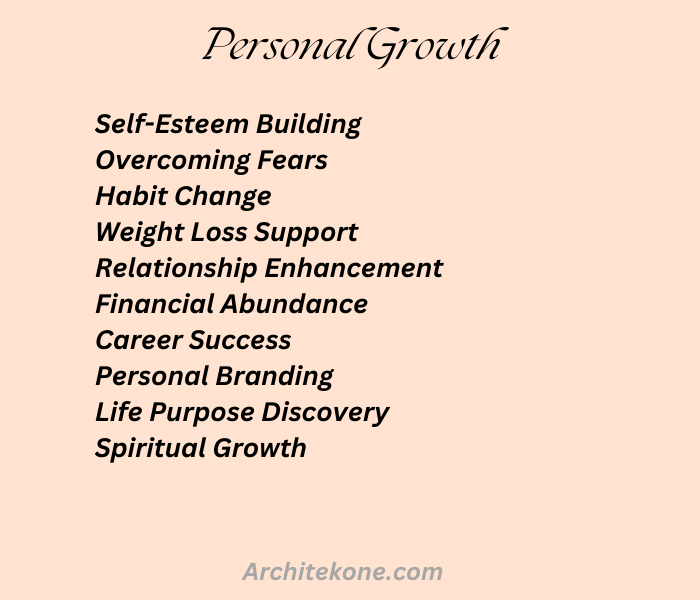
Self-Esteem Building
Self-esteem is the foundation for a fulfilling life. It involves cultivating a positive self-image, recognizing personal strengths, and developing a healthy sense of self-worth. Strategies include building confidence, challenging negative self-talk, setting achievable goals, and practicing self-compassion.
Overcoming Fears
Fears can be paralyzing, but they can also be overcome. This involves identifying the fear, understanding its root cause, and developing coping mechanisms. Techniques such as exposure therapy, cognitive-behavioral therapy, and mindfulness can help individuals challenge their fears and build resilience.
Habit Change
Breaking old habits and forming new ones requires discipline and perseverance. Effective strategies include setting clear goals, identifying triggers, developing alternative behaviors, and rewarding progress. Understanding the science of habit formation can also be beneficial.
Weight Loss Support
Achieving and maintaining a healthy weight involves a combination of diet, exercise, and mindset. Weight loss support encompasses providing information on nutrition, physical activity, and behavior modification. It also includes fostering a positive body image and promoting sustainable lifestyle changes.
Relationship Enhancement
Strong relationships contribute to overall well-being. This area focuses on improving communication, conflict resolution, intimacy, and trust. It includes strategies for building healthy relationships, overcoming challenges, and maintaining connection.
Financial Abundance
Financial well-being is essential for security and peace of mind. This involves developing financial literacy, creating a budget, managing debt, saving for the future, and investing wisely. It also includes mindset shifts towards abundance and financial freedom.
Career Success
Achieving career success requires goal setting, skill development, networking, and job search strategies. It involves identifying career paths, building a strong professional brand, and cultivating a positive work-life balance.
Personal Branding
Personal branding is about creating a unique and compelling identity. It involves defining personal values, strengths, and target audience. Effective personal branding strategies include developing a strong online presence, networking, and storytelling.
Life Purpose Discovery
Finding one’s life purpose involves self-reflection, exploration, and alignment of values with actions. It includes identifying passions, strengths, and contributions to the world. Discovering life purpose can provide direction, motivation, and fulfillment.
Spiritual Growth
Spiritual growth is a personal journey of connecting with one’s inner self and finding meaning in life. It involves practices such as meditation, mindfulness, prayer, and exploring different spiritual philosophies. Spiritual growth can lead to increased self-awareness, compassion, and inner peace.
Problem-Solving & Decision Making
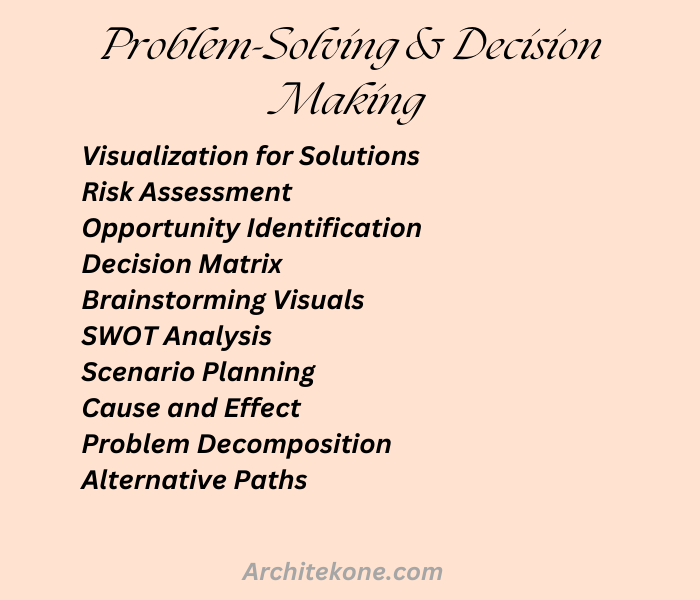
Visualization for Solutions
Visualization involves creating mental images to understand complex problems, identify potential solutions, and explore different outcomes. By visualizing a problem, you can break it down into smaller components, identify patterns, and generate creative ideas.
Risk Assessment
Risk assessment is the process of identifying potential risks, evaluating their likelihood and impact, and developing strategies to mitigate them. Visual tools like risk matrices can help prioritize risks based on their severity and probability.
Opportunity Identification
Identifying opportunities involves recognizing potential areas for growth, improvement, or innovation. Visual techniques such as mind mapping can help brainstorm and connect different ideas to uncover new opportunities.
Decision Matrix
A decision matrix is a tool used to compare and evaluate different options based on specific criteria. By assigning scores or weights to each criterion, you can make informed choices and select the best alternative.
Brainstorming Visuals
Visual brainstorming techniques, like mind mapping or concept mapping, encourage creative thinking and idea generation. By visually connecting ideas, you can explore different perspectives and discover innovative solutions.
SWOT Analysis
SWOT analysis is a strategic planning tool used to assess an organization’s Strengths, Weaknesses, Opportunities, and Threats. Visualizing this information can help identify core competencies, areas for improvement, and potential challenges.
Scenario Planning
Scenario planning involves creating multiple potential future scenarios to anticipate and prepare for different possibilities. Visualizing these scenarios can help understand the impact of various factors and develop contingency plans.
Cause and Effect
Cause and effect analysis helps identify the root causes of problems and their potential consequences. Visual tools like fishbone diagrams (Ishikawa diagrams) can be used to map out complex relationships between causes and effects.
Problem Decomposition
Problem decomposition involves breaking down a complex problem into smaller, more manageable sub-problems. Visualizing the problem as a hierarchy or tree structure can help identify key components and potential solutions.
Alternative Paths
Visualizing alternative paths involves exploring different options and potential outcomes. Decision trees or flowcharts can be used to map out different choices and their consequences, helping to make informed decisions.
Learning & Memory

Mind Mapping for Learning
Mind mapping is a visual organizational tool that helps structure information and ideas. It involves creating a central concept and branching out related ideas and subtopics. This technique enhances understanding, recall, and creativity by providing a holistic overview of information.
Memory Palace Technique
The memory palace, or method of loci, is a mnemonic device that associates information with specific locations in a familiar place. By mentally walking through this imagined space, individuals can recall information by visualizing it at the designated locations.
Visualization for Language Learning
Visualizing language learning involves creating mental images to associate words, phrases, and grammar rules with pictures or scenes. This technique enhances vocabulary retention, pronunciation, and overall language fluency by engaging multiple senses.
Math Concept Visualization
Visualizing mathematical concepts involves creating mental pictures to represent abstract ideas. By transforming equations, formulas, and problems into visual representations, learners can deepen their understanding, identify patterns, and solve problems more effectively.
Historical Event Visualization
This technique involves creating mental images of historical events, people, and places to enhance comprehension and retention. By visualizing the context, characters, and actions involved, learners can develop a deeper connection to the past.
Scientific Concept Understanding
Visualizing scientific concepts entails creating mental models or diagrams to represent complex ideas. By visualizing abstract theories and processes, learners can gain a better understanding of scientific principles and their applications.
Story-Based Learning
Story-based learning involves incorporating narratives into the learning process. By creating stories around information, learners can connect with the material on a personal level, improving engagement, memory, and comprehension.
Visualization for Exam Preparation
Visualizing successful exam performance can reduce anxiety and enhance confidence. By mentally rehearsing the exam environment, answering questions correctly, and feeling calm and focused, learners can improve their performance.
Creative Problem Solving
Visualization is a powerful tool for generating creative ideas. By mentally picturing potential solutions and outcomes, individuals can expand their thinking, identify new possibilities, and find innovative approaches to problems.
Critical Thinking
Visualizing information can enhance critical thinking skills. By creating mental models and diagrams, learners can analyze information from multiple perspectives, identify patterns, and evaluate evidence to reach informed conclusions.
Other Visualization Techniques

Emotional Freedom Technique (EFT)
EFT is a therapeutic approach that combines elements of acupuncture and cognitive behavioral therapy. While not strictly visualization, it involves tapping on specific acupressure points while focusing on negative emotions. This process is believed to release emotional blockages, allowing for clearer thinking and potentially enhancing visualization practices.
Neuro-Linguistic Programming (NLP) Anchoring
NLP is a communication and personal development model that focuses on understanding how the mind works. Anchoring involves associating a specific physical stimulus (touch, sound, or sight) with a desired emotional or physical state. This can be used to trigger specific visualizations or mental states.
Silva Method
The Silva Method is a mind development program that teaches individuals to use their minds more effectively. It involves relaxation techniques, meditation, and visualization exercises to improve problem-solving, creativity, and personal growth.
Holographic Visualization
Holographic visualization is a technique that involves creating a three-dimensional mental image of a desired outcome. It is believed to be more powerful than traditional visualization as it engages multiple senses and creates a more immersive experience.
Remote Viewing
Remote viewing is a technique that involves perceiving information about a distant location or person using mental faculties rather than physical senses. While controversial, it is sometimes associated with visualization and intuition.
Astral Projection
Astral projection is the experience of an out-of-body state where consciousness is perceived as leaving the physical body. While not strictly visualization, it involves mental projection and can be linked to certain visualization practices.
Lucid Dreaming
Lucid dreaming is the awareness of being asleep and dreaming while still in a dream state. It allows for conscious interaction within the dream environment, which can be used for visualization and personal exploration.
Past Life Regression
Past life regression involves guided meditation or hypnosis to explore potential past lives. While not visualization in the traditional sense, it can involve vivid mental imagery and exploration of different perspectives.
Future Life Progression
Future life progression is similar to past life regression but focuses on exploring potential future lives. It can be used for personal growth, goal setting, and exploring alternative possibilities.
Synchronicity Visualization
Synchronicity visualization involves recognizing and appreciating meaningful coincidences or patterns in life. By focusing on these synchronicities, individuals can develop a deeper sense of connection and purpose, potentially influencing visualization practices.
Final Thoughts
The ability to visualize effectively is a skill that can be cultivated and refined over time. Consistent practice is key to developing a strong visualization habit. Remember, the mind is a powerful tool, and with focused intention, we can harness its potential to create the life we desire.
By incorporating visualization techniques into your daily routine, you can tap into a wellspring of creativity, motivation, and resilience. Whether you choose to focus on achieving specific goals, cultivating inner peace, or enhancing your overall well-being, visualization can be a catalyst for positive change.
Experiment with different techniques, find what resonates with you, and most importantly, enjoy the journey of self-discovery and transformation.

